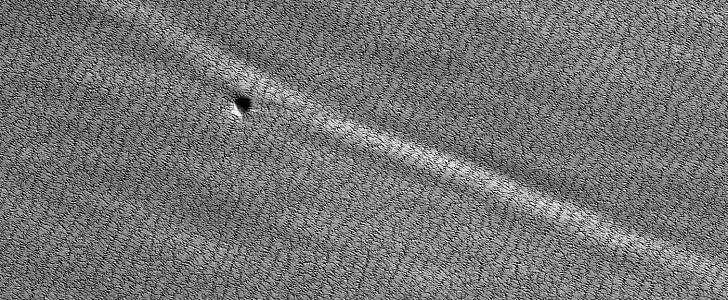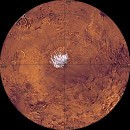It’s not a secret we humans are far from properly understanding neighboring planet Mars. The place that might have been a second Earth-like planet in the solar system is long dead, but filled with mysteries that have fueled the imagination of dreamers for centuries.
As it happens, Mars is also our safest bet when it comes to the first alien planet we could visit. Plans are being drafted for crewed missions, after for years the place has been under the intense scrutiny of a number of pieces of hardware sent there in the hopes they’ll provide us with a better understanding of what Mars is all about.
In all fairness though, some of the observations made have done nothing but to deepen the mystery, and prove we’ll probably never truly understand what happened there long ago.
Take the image we have here. It was shot with the HiRISE orbital camera back in 2015, from an altitude of 246 km (153 miles), and it shows a region at the planet’s South Pole. And it contains two mysteries.
The first would be “a bright, bow-shaped marking” that runs diagonally from left to right in the pic. NASA and the University of Arizona, who run HiRISE, don’t really know how the feature came to be, calling it a “mysterious bright streak.”
Given the abundance of channels that are usually associated with the sublimation of carbon dioxide during spring and the assumption that it may have appeared because of some topographic shading, scientists speculate “this portion of the layered deposits may have been folded under compressional stresses, perhaps from gravitational slumping.”
The second mystery is the single feature that breaks the monotony of the image, a zit that may be an impact crater, “although now too degraded to be certain of its origin.”
People who look at Mars for a living have just begun analyzing this particular image, despite it being six years old now. That’s because the number of photos sent back by HiRISE over the years is simply staggering, and work on them will probably continue long after we humans have reached the planet themselves.
In all fairness though, some of the observations made have done nothing but to deepen the mystery, and prove we’ll probably never truly understand what happened there long ago.
Take the image we have here. It was shot with the HiRISE orbital camera back in 2015, from an altitude of 246 km (153 miles), and it shows a region at the planet’s South Pole. And it contains two mysteries.
The first would be “a bright, bow-shaped marking” that runs diagonally from left to right in the pic. NASA and the University of Arizona, who run HiRISE, don’t really know how the feature came to be, calling it a “mysterious bright streak.”
Given the abundance of channels that are usually associated with the sublimation of carbon dioxide during spring and the assumption that it may have appeared because of some topographic shading, scientists speculate “this portion of the layered deposits may have been folded under compressional stresses, perhaps from gravitational slumping.”
The second mystery is the single feature that breaks the monotony of the image, a zit that may be an impact crater, “although now too degraded to be certain of its origin.”
People who look at Mars for a living have just begun analyzing this particular image, despite it being six years old now. That’s because the number of photos sent back by HiRISE over the years is simply staggering, and work on them will probably continue long after we humans have reached the planet themselves.







